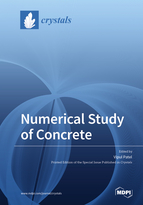Numerical Study of Concrete
A special issue of Crystals (ISSN 2073-4352). This special issue belongs to the section "Industrial Crystallization".
Deadline for manuscript submissions: closed (31 July 2020) | Viewed by 76641
Special Issue Editor
Interests: concrete-filled steel tubular structures; nonlinear analysis; steel structures; concrete structures; finite element analysis
Special Issues, Collections and Topics in MDPI journals
Special Issue Information
Dear Colleagues,
Concrete is one of the most widely used construction materials in the word today. Research in concrete follows the environment impact, economy, population, and advanced technology. This Special Issue invites recent numerical studies for research in concrete. Some of the topics of interest include finite element analysis, digital concrete, the reinforcement technique without rebars, and 3D printing.
Dr. Vipul Patel
Guest Editor
Manuscript Submission Information
Manuscripts should be submitted online at www.mdpi.com by registering and logging in to this website. Once you are registered, click here to go to the submission form. Manuscripts can be submitted until the deadline. All submissions that pass pre-check are peer-reviewed. Accepted papers will be published continuously in the journal (as soon as accepted) and will be listed together on the special issue website. Research articles, review articles as well as short communications are invited. For planned papers, a title and short abstract (about 100 words) can be sent to the Editorial Office for announcement on this website.
Submitted manuscripts should not have been published previously, nor be under consideration for publication elsewhere (except conference proceedings papers). All manuscripts are thoroughly refereed through a single-blind peer-review process. A guide for authors and other relevant information for submission of manuscripts is available on the Instructions for Authors page. Crystals is an international peer-reviewed open access monthly journal published by MDPI.
Please visit the Instructions for Authors page before submitting a manuscript. The Article Processing Charge (APC) for publication in this open access journal is 2600 CHF (Swiss Francs). Submitted papers should be well formatted and use good English. Authors may use MDPI's English editing service prior to publication or during author revisions.
Keywords
- Analysis
- Concrete
- Recycle materials
- Compression strength






